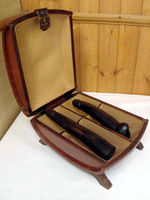Dildo: Różnice pomiędzy wersjami
Z Almanach
mNie podano opisu zmian |
mNie podano opisu zmian |
||
| Linia 5: | Linia 5: | ||
<gallery caption="Fallusy" widths="200px" heights="200px" perrow="4"> | <gallery caption="Fallusy" widths="200px" heights="200px" perrow="4"> | ||
Plik:Almanach_Dildo_XVIII.jpg|Dildo znalezione w klasztorze, ([[XVIII]] wiek) | Plik:Almanach_Dildo_XVIII.jpg|Dildo znalezione w klasztorze, ([[XVIII]] wiek) | ||
Plik:81074 18C dildos 1 1000 123 285lo.jpg|Drewniane dildo w szkatule wyłożonej skórą, ([[XVIII]] wiek) | |||
</gallery> | </gallery> | ||
== Bibliografia == | == Bibliografia == | ||
<references/> | <references/> | ||
Wersja z 13:22, 22 maj 2012
From Philip S. Rawson’s Primitive Erotic Art: “”In Europe through medieval times, even into the eighteenth century, it was customary for dildos (called ‘love gods’ or ‘love birds’), which were roughly shaped as phallic-headed birds, to be sold openly in markets.”[1]
From Claude J. Summers’ The Queer Encyclopedia of the Visual Arts, “The English word “dildo” is first recorded around 1592, in a poem by John Nashe. John Donne in his licentious elegies also refers to dildos. In the eighteenth century, Fuseli drew a woman wearing one.”[2]
- Fallusy
Dildo znalezione w klasztorze, (XVIII wiek)
Drewniane dildo w szkatule wyłożonej skórą, (XVIII wiek)

